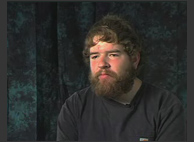| NIMH: Autism Spectrum Disorders | |
| NICHD: Autism and the MMR Vaccine | |
| Richard, Age 52 | |
| Jeff, Age 35 | |
| NIMH: Autism Spectrum Disorders (pdf) | |
| CDC: Learn the Signs Information Card (pdf) | |

Cultural Differences
Culture plays a large role in parents’ expectations regarding developmental milestones, such as speaking their first words or phrases, toilet training, and walking or crawling. Since cultural factors are intertwined with thoughts and behaviors, they may assume a major role in the way families think about deviations in their children’s development. For example, Puerto Rican mothers expect their children to be toilet trained at a significantly earlier age than white mothers, but white mothers expect their children to be able to name their colors at a significantly earlier age than Puerto Rican mothers.
Specific to autism, studies have found that Indian parents are more likely to identify delays in socialization than delays in speech, while American families are more likely to detect general developmental delays or regression in language skills rather than social deficits. In fact, one study found that parents of children with autism in the United States did not provide any information specific to their child’s social interactions unless probed by their clinician.
These findings suggest that clinicians should initiate lines of questioning regarding both socialization and communication if parents bring up concerns in one of these areas. It also means that, while parental concerns are often highly predictive of developmental delay, clinicians can not wait for parents to bring up concerns, but must initiate screening themselves.
Even if parents’ recognize the symptoms of autism, there may be cultural differences in to what they attribute them. As with other developmental and psychiatric disorders such as ADHD, families may attribute symptoms to something other than a health condition. For example, a child’s failure to respond to parental direction may be interpreted as “willfulness”5 and other unusual behaviors as falling within the bounds of normalcy. For example, Asian/Pacific Islander and African American parents are less likely than white parents to agree with teachers that their children’s behavior is indicative of an underlying disorder. Clinicians may have to work with parents to help them understand that symptoms are indicative of an underlying pathology that can benefit from treatment.
Clinician-family interactions
The most obvious way in which culture can impede clinician-family interactions is in the area of language. A developmental history based on parent report is especially crucial in diagnosing autism spectrum disorders. One option in attempting to bridge a language barrier is the use of a translator. A professional translator should be utilized, because friends or family of the individual may hesitate to discuss personal issues or may unintentionally misrepresent information.
Bi-lingual or non-English speaking children may be at a disadvantage during assessment since language development is a key criterion in diagnosing autism. There are currently no screening instruments available to account for a language development discrepancy for a child who is learning two languages at once. For a parent or guardian who does not speak English fluently, the interpretation of the language within a screening instrument may also be a barrier to accurate assessment since languages and cultures do not always have similar meanings for words or phrases. You can learn more about screening instruments and their cross-culture application by viewing the Fact Sheets available on the Parents Involved Network of Pennsylvania website (www.pinofpa.org).
There are many other factors surrounding interpersonal interaction and communication which may differ greatly across cultures. Variations in how cultures consider physical contact/closeness, certain body movements and gestures, gender roles, sexuality beliefs and family interactions like decision-making may contribute to communication barriers just as variations in language do. These discrepancies should be considered as they provide more of an opportunity for a barrier in communication and therefore diagnosis.
Clinicians should be especially sensitive to bedside manner when interviewing families of other cultures. A growing body of research suggests that individuals of other cultures are more likely to feel that clinicians did not listen to their concerns or dismissed them altogether.19, 20 Clinicians should be sensitive to the fact that families other cultures may use different words to describe phenomena and assign them different values. Remember to continually ask questions and paraphrase until families indicate that they think their concerns are understood. Clinicians may also want to consider using the following questions to make sure they understand families’ conceptions of the difficulties their children are facing:
- What do you call your child’s problem?
- What do you think caused it?
- Why do you think it started when it did?
- How severe is it? Will it have a short or long course?
- What are the chief problems your child’s problem has caused him and you?
- What do you fear most about it?
- What kind of treatment do you think your child should receive? What do you expect from this treatment?
There also are several multilingual resources available to help educate parents and caregivers about ASD and developmental delays. The Parent Advocacy Coalition for Educational Rights (P.A.C.E.R) is a national center based in Minnesota. Their website (www.pacer.org) contains a section of educational materials about education and developmental delays available translated in various languages. The Special Parents Information Network (S.P.I.N.) located in California also has a resource library available in both English and Spanish that can be found on their website (www.spinsc.org). The “Cultural Competency Resources” section of the Pennsylvania Parents & Caregivers Resource Network (P.P.C.R.N.) website (www.ppcrn.org) provides information, including an assessment scale, for clinicians.
Mandel



